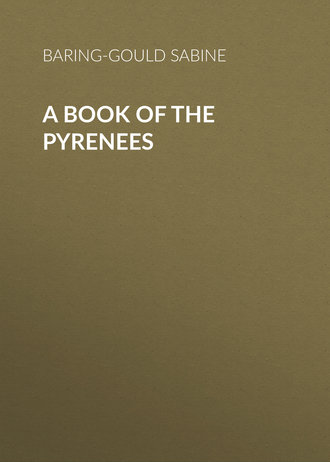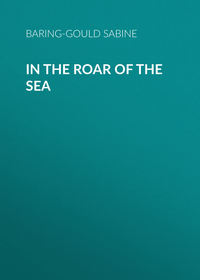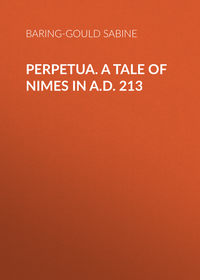 полная версия
полная версияA Book of the Pyrenees
I can recall rides en cacolet as customary among the Basques some sixty years ago, now quite obsolete. A horse was furnished with two baskets, one on each side, and two persons were accommodated, one in each basket. Inglis says in 1835: —
“Morning, noon, and evening, the road between Bayonne and Biarritz is crowded with travellers en cacolet. The horses belong generally to the women who drive them; these women are generally young, many of them handsome. They generally speak French, Basque, and a little Spanish, and are rather intelligent than otherwise, always carrying on an unintermitting conversation during the whole ride. The horses are usually indifferent; they go at a small trot, and perform the trajet in about forty minutes.”
One of the most puzzling facts in the study of mankind is the manner in which the most unmeaning customs are found extended far and wide. I shall have something to say of the couvade in another chapter. There is another which is met with in the Basque country, and which is also, or was, usual in Yorkshire. On Easter Monday the girls seize on lads and heave them up in the air, and hold them aloft till they redeem themselves with a coin or a kiss. On Tuesday the boys enjoy the same privilege with the girls. I have been so lifted up near Bayonne. I recall an instance in Yorkshire, where H.M. Inspector of Schools, a grave and reverend signor, came to a manufacturing town on Easter Monday. As he was sedately walking from the station he encountered a bevy of mill lasses, when at once he was uplifted by them and carried in triumph, in vain expostulating, and a kiss from him was demanded by each before he was released.
So with April Fools’ Day —le poisson d’avril– it is honoured in the same fashion in Hindustan as in Europe.
Few visitors to Biarritz fail to take a run over the frontier into Spain. The Bidassoa for about twelve miles forms the line of demarcation between France and Spain. Near the bridge of Behobia are the remains – they are nothing more – of the Ile des Faisans, on which conferences were held between Cardinal Mazarin, plenipotentiary for France, and Don Luis da Haro, acting for Spain, which led to the conclusion of the famous Treaty of the Pyrenees, in 1659, cemented by the marriage of Louis XIV with the daughter of Philip IV. At the meeting on the Ile des Faisans each party advanced from its own territory by a temporary bridge to this patch of neutral ground in mid-stream. The death of Velasquez, the painter, was due to exposure whilst superintending the decoration of the tent for the minister of Spain – a duty more befitting an upholsterer than a great artist. By the treaty France received la Cerdagne and Roussillon, but surrendered Lorraine to Duke Charles IV, on condition that he should dismantle all its fortresses. As he delayed doing this Louis retained his hold on the duchy.
Fontarabie (Fuenterrabia) does not signify the Fountain of Arabia, and retains in its name no reminiscence of Moorish domination; the derivation is from the Latin fons rapidus. It is a picturesque, dirty town, malodorous; bearing as its arms in quarterings an angel holding a key, to signify that the town holds the key of Spain – a squalid beggar would be more appropriate than an angel; a whale and two syrens, the whale to indicate the fishing of the leviathan, now long departed; and lastly a castle between two stars. These arms were accorded to Fuenterrabia by Philip IV in 1638, when the admiral of Castile repulsed the Prince of Condé, who was besieging it. The church, Gothic in style, has been modernized externally; within it is overloaded with barbaric ornament. The castle, known as the palace of Charles V, dates originally from the tenth century, but has undergone much rebuilding and adaptation. The courtyard is picturesque, and the terrace commands a beautiful view.
Fuenterrabia brings no pleasing remembrances to an Englishman. The citizens begrudged a lodging to our sick and wounded during the passage of the Pyrenees by the allied troops under Wellington when in pursuit of Soult in the depth of winter. The town authorities even wanted to take away the boards on which were stretched the disabled soldiers. “These,” wrote the Duke, “are the people to whom we have given medicines, etc., whose wounded and sick we have taken into our hospitals, and to whom we have rendered every service in our power, after having recovered their country from the enemy.”
Irun signifies in Basque “the good town,” but it contains little that is good, nothing that is interesting. Passages, however, will arrest the traveller, owing to its picturesque harbour, land-locked, and the entrance commanded by the castles – reminding a Devonshire man of Dartmouth. The port has been neglected and suffered to be silted up, although the rock-bound coast possesses no better harbour of refuge for storm-tossed boats.
San Sebastian has suffered so severely from sieges that it has lost its medieval character; but nothing can destroy its natural beauty of situation. The Monte Urgull, on which is the castle, was originally a rocky island, but it has been united to the land by the deposits of the River Urumea, and the town now occupies this neck. Beyond is the concha, a semi-lunar bay, with excellent sands, and with the Isle of Sta. Clara breaking the force of the waves that roll in from the Atlantic. San Sebastian is the most fashionable seaside resort in Spain, and is much frequented by the nobility and by well-to-do citizens of Madrid. The church of S. Vincent is a Gothic edifice of 1507. San Sebastian is memorable for its siege by Wellington. Mr. Ford says: —
“It was obtained in March, 1808, by Therenot, when the French got in under false pretences. They held it during the war, and being in the rear of the Duke when advancing in 1815 on the Pyrenees, it retarded his progress, and its possession became absolutely necessary. This was a work of great difficulty, for the naturally strong position was garrisoned by 3000 brave French veterans under General Rey, and the Duke, from the usual neglect of our Government, in spite of repeated applications to Lord Bathurst, was forced to wait from 25 July to 26 August for want of means even to commence operations, during which time the active enemy strengthened their defences, being supplied from France by sea.
“In vain the Duke had warned Lord Melville, under whose fatal rule the navy of England was first exposed to defeat, and who now did his best to ensure a similar misfortune to the army. And to make matters worse, Graham, to whom the siege was entrusted, neglected the advice of Sir C. Felix Smith and of Sir R. Fletcher. Graham having failed in a night attack on 24 August, the Duke was forced to come in person to set matters right. His arrival was, as usual, the omen of victory. Now the town was assaulted as it ought to have been at first, from the chafres or sand banks, and was taken on 31 August. The French, after a most gallant defence, retired to the upper citadel, on which, by the almost superhuman efforts of the engineers, backed by the bluejackets, guns were brought to bear, and it surrendered on 9 September, two-thirds of the valorous garrison having perished, while nearly 5000 English troops were killed and wounded.”
Wellington – then only the Marquess Wellesley – had not bombarded the town, so as to spare the inhabitants, but General Rey himself had set fire to the town on 22 July, as is admitted by him in his own dispatch, and it was done for the express purpose of hampering the progress of the English, when he saw that the place must inevitably fall; and this, when Wellington would not suffer his batteries to play upon the town.
When finally San Sebastian was taken, all control over the soldiers, who were exasperated by the stubborn resistance, was for a while lost. A thunderstorm burst at the same time that the soldiers broke in, and a scene of riot and rapine ensued. In the midst of explosions of thunder and lightning the city was sacked. Fires broke out in various places, and flames waved over such houses as had been spared by Rey. At the same time the garrison of the castle ploughed the streets with their artillery, killing alike inhabitants flying from the English, Spanish and Portuguese soldiery, as well as the soldiers themselves. It was found impossible to extinguish the flames or to control the soldiers. The most was made of this. Napoleon wrote: “Les Anglais commettent des horreurs dont les annales de la guerre offrent peu d’examples, et dont cette nation barbare êtait seule capable dans un siècle de civilisation.” But Napoleon never minced words. The sack of San Sebastian, though regrettable, was mild in comparison with the atrocities committed by the French elsewhere in Spain. In justice it must be said that it was not English alone who were guilty of these excesses, but the far more lawless Spaniards and Portuguese who formed our allies, and that the sack was stopped as soon as ever Wellington was able to gain control over the maddened soldiery.
CHAPTER IV
S. JEAN-PIED-DE-PORT
Four valleys – The Basque land – Quarrels with Bayonne – The Sieur de Puyane – Cambo – Itxasson – Pas de Roland – Stalagmitic saint – S. Jean-Pied-de-Port – The first book in Basque – Patronal feasts – Roncevaux – The Song of Roland – The history of Turpin – Death of Roland – His horn – Convent – Canons – Virgin with diamonds in her eyes – Spanish kitchen – Smugglers – Escape of the Princess of Beira – The Couvade.
From the ridge of the Western Pyrenees descend four large valleys towards the north, each with a river running at the bottom. The westernmost and least important is that of the Nivelet, that flows into the Bay of Biscay at S. Jean de Luz. The second thence is the Nive, that discharges its waters into the Adour at Bayonne. The third is the Bidouze, which reaches the Adour just below where that river receives the mingled waters of the two Gaves. The last of these, and the easternmost of these rivers, is the Cenon, that loses itself in the Gave of Oloron, near Sauveterre.
In the ancient geography of France these four valleys were somewhat irregularly divided into districts, of which the westernmost was called Labourde, and the easternmost Soule, and the central portion was Lower Navarre. Taken collectively these districts constitute the Basque land, the population of which was closely related in language, habits, and blood to the inhabitants of Biscay, Guipuzcoa, and Upper Navarre in Spain. The narrow strip of land comprising the two cantons of S. Palais and S. Jean-pied-de-Port was for many centuries regarded as forming a parcel of the province of Gascony, but Alphonso the Noble took it, together with Labourde, from the English King John, so that it became a portion of the kingdom of Navarre, though Bayonne was recovered by the English. Sancho, King of Navarre, strengthened his hold on it more firmly, but eventually, when the claim to the crown of Navarre passed to the Counts of Foix and Viscounts of Béarn, it was the sole portion of that kingdom that these latter were able to retain, the Spanish Navarre having been annexed by Ferdinand the Catholic.
The Basques never obtained political independence. They were always subjected to Frank or English domination; they passed under the rule of the kings of Navarre and counts of Foix, and finally under the crown of France. Nevertheless they succeeded in maintaining a communal right of self-government, and enjoyed great privileges, notably that of conveying their wares and those of Spain free of duty to the markets of Toulouse and Bordeaux; rights these that awoke the jealousy of the citizens of Bayonne, who were incessantly at feud with them. The Bayonnais claimed Villefranche as belonging to Labourde, because the tide flowed through the arches of the bridge there. In an affray over this the mountaineers killed several citizens of Bayonne. In reprisal, in the reign of Edward III of England, Duke of Gascony and Aquitaine, the mayor of Bayonne, a Sieur de Puyane, descended on Villefranche on S. Bartholomew’s Day, when a fair was being held there, caught five burgesses of note and fastened them to the arches of the bridge, and let them drown to show by occular demonstration that the tide did rise to Villefranche, and that therefore it was within the jurisdiction of Bayonne. The Basques rose en masse and massacred the Labourdins wherever they caught them. Finally, both parties appealed to the arbitration of the Sieur d’Albret, and the town of Bayonne was condemned to pay a heavy sum as indemnity to the families of the drowned men. The Bayonnais appealed to the King of England. He mitigated the fine, but the Basques would only consent to his adjudication on condition of reserving the right to pursue the sons of the Sieur de Puyane till they had exterminated the family. This was the last act by which the Basque nation manifested its political existence. But they retained their special privileges till the French Revolution, when the common law of France superseded all local independence of jurisdiction.
Cambo is a pretty, pleasant place, that has of late years risen to notice as a health resort. It takes its name from what has been supposed to be an Euscaldunic, i.e. Basque camp. I planned this and sent plan and description to the Archæologia, in 1852. But with greater experience of ancient camps than I had then, I have come to doubt whether it is what has been supposed. It consists of a platform on a hillock with a network of trenches about it, and ridges between them sharp as the back of a knife. It may have been used as a camp of refuge, but it could not contain a large force, and the dykes around appear to have been formed by currents of water.
Itxasson is an eminently Basque village. The church contains rich ornaments of silver gilt for the altar, given in the eighteenth century by an emigrant, Pedro d’Echegaray, on his return from America, where he had realized a fortune. The Basques, it may be noticed, do not give their names to houses and farms, but assume as surnames those place names from which they came.
From Itxasson the Pas de Roland is reached in half an hour on foot. It is an archway bored in the crag beside the river. Road and railway have so maltreated the rock that the Pas is now hardly worth a special visit. It was through this arch that the Roman road passed, and through it Roland the Paladin went to his death at Roncevaux. According to local legend Roland set his foot against the rock and burst a way through it by pressure. Road and rail now enter the mountains following the river.
At Bidarray, on the mountain-side, is a grotto, about thirty feet deep. In one corner a ladder conducts to a cavity, at the back of which is a stalagmitic incrustation three feet high, of a livid hue, rudely representing a human torso. This is held in high veneration by the peasantry, and is called “the Saint of Bidarry,” though who the saint was whom it is supposed to represent nobody can say. A very similar incrustation occupies a niche in the Gorge of the Ardèche, and is there held to be a lively presentation of Charlemagne. Sick people seek this cave and soak rags in the water that dribbles from the figure, and which has in fact built it up. They apply the rags to the suffering parts of their bodies, and depart believing themselves to be healed, but the rags are left behind as ex votos.
S. Jean-Pied-de-Port was the key to the port or pass into Spain, and especially to the communication between Upper and Lower Navarre. It occupies a point where three streams fall into the Nive. There had been a Gallo-Roman town three miles distant at S. Jean-le-Vieux, but it had been destroyed by the Saracens. The present town was founded by the Garcias, kings of Navarre, in the eleventh and twelfth centuries. S. Jean, from the Treaty of the Pyrenees to the Revolution, during three reigns, was the capital of French Navarre. There are several old houses in the town, some of the Renaissance Period, and owing to their being built of red sandstone have a warm and pleasant aspect. The citadel was constructed by Deville in 1668, but was remodelled by Vauban, as were also the ramparts of the town.
The first book in Basque that was printed and published was by Bernard d’Echepare, curé of S. Jean-Pied-de-Port, in 1545. It consists of two parts. The first contains Christian doctrine, moral sentences, and passages from Scripture, good for edification. But strangely united with this, under the same cover and with continuous numeration of pages, is a collection of the priest’s erotic poems.
Si … turpiter atrumDesinat in piscem mulier fermosa superne,Spectatum admissi risum teneatis, amici?He frankly admits that he had had his love adventures. “I would not go to heaven, not I,” he tells us, “unless I were sure of meeting women there.”
He gives us a picture of female charms too highly coloured to bear reproduction. He throws in episodes from his own experience. In one of his escapades he got into such a scrape that he was incarcerated by order of the king of Navarre. “Il est à regretter,” says Michel, “qu’il se soit borné à nous parler de sa détention, sans en indiquer ni la cause, ni le lieu, ni l’époque.”
S. Jean-Pied-de-Port should be visited at the time of its patronal fête, 15 to 18 August, where day and night are given up to concerts, games, masquerades, and allegorical dances performed by the peasants of la Haute Soule.
But should a visitor be there at midsummer he should make an effort to push on to Pampeluna for the fête of 7 July, when for over a week the city keeps holiday —les gigantes parade the streets, monstrous figures, representing Moors; and the Alcalde and Corporation dance in front of the cathedral in honour of S. Firmin, the patron saint. He will, moreover, have an opportunity of seeing the pretty Navarrese girls, who have come out of the country for the great annual merry-making.
But the place of highest historic and romantic interest to be visited from S. Jean-Pied-de-Port is Roncevaux. Here, on 15 August, 778, the army of Charlemagne met with a crushing defeat, in which Roland and the twelve peers of the emperor were overwhelmed by rocks hurled down on them by the Basques.
The contemporary Eginhard tells us that the king invaded Spain at the head of a huge army, pushed on as far as Saragossa, and there received hostages from the Saracen chiefs. On his return, whilst entangled in the Pyrenean pass, the Basques attacked his rearguard, which perished to a man. Most of the officers of the palace, to whom Charlemagne had confided the command of the troops, were among the slain, and with them “Roland, prefect of the Marches of Brittany.”
No revenge could be taken for this disaster, as the light-footed mountaineers dispersed, and could not be reached. This is all we know for certain, but even in this account the existence of Roland among the captains slain is doubtful, as the passage referring to him is an interpolation, and is not found in the best MSS. copies.
In 810 Louis “le Debonaire,” at that time King of Aquitaine, on his return from an expedition into Spain, took the precaution of securing the wives and children of the Basques and retaining them as hostages till he was safely through the pass. But in 824 the Frank army descended to Pampeluna, under two counts, and on its way back was surprised at Roncevaux by the Basques; the troops were slaughtered and the counts taken. These two disasters in popular tradition were run into one, and gave occasion to the composition of the “Song of Roland,” one of the finest pieces of medieval poetry that we possess.
“‘The Song of Roland,’” says Mr. Ludlow, “apart from any question of literary merit, has a peculiar interest for our country, not only as forming one of the treasures of the Bodleian, but from its connexion with one of the half dozen greatest events in our history – the Battle of Hastings. For there, as we are told by Wace, William of Normandy’s minstrel ‘Taillefer who full well sang, on a horse that was swift, went before them singing Of Charlemagne and of Roland, and of Oliver and of the vassals who died at Roncevaux.’”5
The very earliest text extant of this poem is in the Bodleian Library at Oxford. All other songs of Roland are amplifications of later date.
Thus it appears that to the chanting of this ballad by a minstrel William went forward to the conquest of England.
One of the most popular books of the Middle Ages was the History of the Life of Charlemagne and of his Nephew Roland, which passed as the composition of Turpin, Archbishop of Rheims, a man who died about 800. It was a historical romance based on old ballads, composed in the twelfth century, and of no historic value whatsoever. Pope Callixtus II formally decided, however, in 1122, that it was veracious history.
In this book we have the fully-developed story of the defeat at Roncevaux. In it, declared by an infallible Pope to be authentic and trustworthy, we are informed that Charlemagne was eight feet high, measured by his own feet, “which were of the largest size,” that at a meal he would consume a quarter of a sheep, and if that were not at hand, then he would appease his appetite with two fowls, or a duck, a peacock, a crane, or a hare.
The army had marched into Spain, and Roland and Ganilon the Traitor had been sent forward to Saragossa on an embassage to the Soudan, who, according to the counsel of Ganilon, spake fair and consented to all Charlemagne’s demands. Consequently the host of the Franks returned through the Pyrenees, unsuspicious of evil. Charles led the van, and Roland and Oliver the rearguard. Meanwhile the Saracens had gone about by bypaths, and they suddenly appeared to intercept the march of that body of men which was under the command of Roland and Oliver. A furious fight ensued, Oliver fell, and Roland alone survived. Then he put his ivory horn to his lips and blew such a blast that Charles heard it, though many leagues away, and he knew thereby that his nephew was in danger. With the blast Roland broke a blood-vessel, and, sinking to the ground, he dashed his good sword Durandal against the rocks with intent to break it, lest it should fall into the hands of the paynim.
To this day at Roncevaux a mass is said in May above the tombs of the paladins, in the little chapel supposed to have been founded by Charlemagne, and this mass is for the repose of the souls of those who fell in the massacre of Roncevaux.
Roncevaux itself consists of a few poor huts about a monumental convent, from the midst of which rises the church with a massive square tower. The “royal and illustrious collegiate church” was considered in Spain to be the fourth in order of the holy spots on earth. The other three were Jerusalem, Rome, and Compostella. The chapter was under the special protection of the Holy See, and the King of Spain nominated the prior. This dignitary and six canons are all that remain of the ancient order of Roncevaux. Throughout the convent may be seen its badge, a cross, the middle member curved at the head like a pastoral staff, and with a sword at the feet.
Pilgrims from France, Germany, and Italy were wont to cross the Pyrenees on their way to Compostella, and many lost their lives in the snow. On this account, in 1131, the Bishop of Pampeluna founded a hospital at Roncevaux for their accommodation, and he dispatched one of the canons of his cathedral to attend to the requirements and comforts of the pilgrims. This was the origin of the convent that grew rich with the gifts of kings and princes who were lodged there. The canons of Roncevaux wear a sleeveless surplice and a black amice over their shoulders in summer, but in winter a thick black cloak and a furred hood. When they go out they wear a short linen scapular over their cassocks.
Under the tower is a Gothic hall. This, with the cloister and the church, was erected by Sanchez the Strong, King of Navarre, in the thirteenth century. He and his wife repose in the church under a marble tomb.
In this church is a Mater Dolorosa, the eyes of which are apparently full of tears. This appearance is due to the insertion of diamonds, but the ignorant peasantry are fully convinced that the eyes of the Madonna really brim with tears for their sorrows, and out of profound compassion.
Near the convent formerly stood a pillar commemorative of the defeat of Charlemagne’s rearguard, but the monument was destroyed in 1794 by two commissioners of the French Republic, to the performance of a “musique touchante.” These men headed a column called l’Infernale; it entered Spanish territory, and carried fire and sword everywhere. They pillaged the church and the convent, and wrecked all they could lay hands on.









